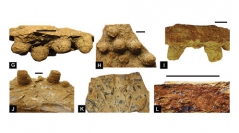

 Comptes Rendus Palevol
18 (3) - Pages 287-297
Comptes Rendus Palevol
18 (3) - Pages 287-297The probable trace maker of B. hemispherica is the fact that one encounters different age groups of sea anemone burrows extended at variable depths in soft, unconsolidated, non-fluidized mud to get stability. It occurs as densely packed, vertical to subvertical, usually unornamented, occasionally showing faint, thin, ring-like structures, allochemic sandstone-filled cylinders with hemispherical base extending to variable depths in the shale. The diameter-to-height ratio calculated for 44 burrow specimens shows that the diameters of most of the specimen are smaller than their height. The probable trace maker of B. hemispherica is the fact that one encounters different age groups of sea anemones, which extended their column at variable depth in soft, unconsolidated, non-fluidized mud to get stability. The inclined nature of paired burrows towards each other suggests social aggression while unpaired inclined burrows suggest swaying in search of food. The monodominant occurrence of B. hemispherica as pre-storm colonization of r-selected organisms (sea anemones) suggest sstressed environment and simultaneous vacation of the burrower reflects rapid sedimentation due to high-energy storm events. Further, storm and inter-storm events deposited sandy allochemic limestone and shale series, respectively, but did not form an identical condition for the colonization of the sea anemone. The species B. hemispherica of the Bagh Group revealed physicochemical parameters (energy conditions, turbidity, sedimentation rate, bathymetry, suspended organic matter, substrate consistency, oxygen, and salinity) of the Late Cretaceous transgressive sea.
Plug-shaped burrows, R-selected organisms, social aggression, physicochemical parameters, shoreface, Turonian